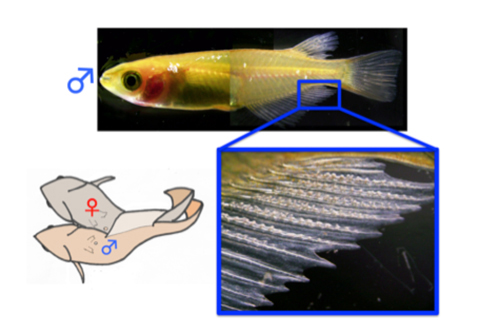
National Institute for Basic Biology




2013.12.12
Androgens play key roles in the morphological specification of male type sex attractive and reproductive organs, while little is known about the developmental mechanisms of such secondary sex characters. Medaka offers a clue about sexual differentiation. They show a prominent masculine sexual character for appendage development, the formation of papillary processes in the anal fin, which has been induced in females by exogenous androgen exposure. The research group of Professor Taisen Iguchi and Assistant Professor Yukiko Ogino of the National Institute for Basic Biology’s Division of Molecular Environmental Endocrinology, in collaboration with the Tokyo Institute of Technology, Wakayama Medical University, University of Florida, and the National Institute for Environmental Studies, has shown that the development of papillary processes is promoted by androgen-dependent augmentation of Bone morphogenic protein 7 (Bmp7) and Lymphoid enhancer-binding factor-1 (Lef1). Androgen receptor (AR) subtypes, ARα and ARβ, are expressed in the distal region of outgrowing bone nodules of developing papillary processes. Development of papillary processes concomitant with the induction of Bmp7 and Lef1 in the distal bone nodules by exposure to methyltestosterone (MT) was significantly suppressed by an anti-androgen, flutamide, in female medaka. When Bmp signaling was inhibited in MT-exposed females by its inhibitor, dorsomorphin, Lef1 expression was suppressed accompanied by reduced proliferation in the distal bone nodules and retarded bone deposition. These observations indicate that androgen-dependent expressions of Bmp7 and Lef1 are required for the bone nodule outgrowth leading to the formation of these secondary sex characteristics in medaka. The formation of androgen-induced papillary processes may provide insights into the mechanisms regulating the specification of sexual features in vertebrates.

The formation of papillary processes in the anal fin of male Medaka